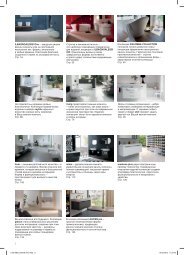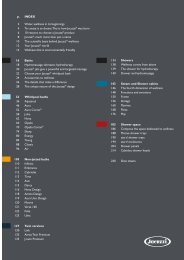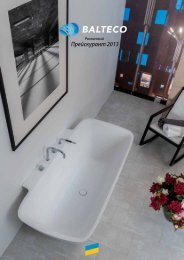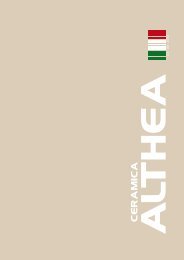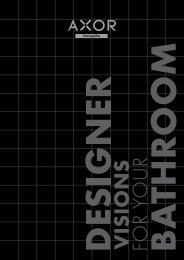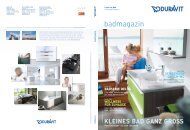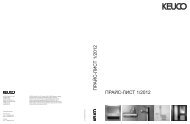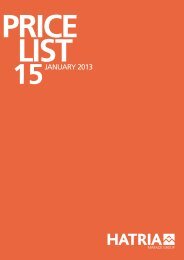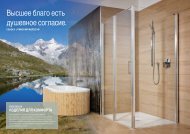Butech, 2012.pdf
You also want an ePaper? Increase the reach of your titles
YUMPU automatically turns print PDFs into web optimized ePapers that Google loves.
30<br />
The correction factors in dB, which are necessary to obtain the corresponding data for 40NA panels (of 40LA) and 30KA (of 35kA) are shown in the table below.<br />
Type of coating Correction factor [dB]<br />
calcium sulfate 30K -1<br />
Chipboard 40N 0<br />
Natural stone (S) and reconstructed (R), Ceramic tile (T<br />
-1<br />
Finally, the correction factors in dB are shown below for obtaining panel data with a lower cover in steel instead of aluminum.<br />
Below are some examples of how to get the data for each particular group.<br />
Type of coating Correction factor [dB]<br />
Steel (F) 0<br />
Ex.1: Panel 40LAT on a structure with stringers<br />
1. In diagram 1 the data in relation to the panel 40LA0 with stringers obtained are M = 34 dB;<br />
2. From Table 1 is extracted correction factor for the coating of tiles (T), which is - 1dB. The horizontal aerial noise reduction is, therefore, (Dnfw) 34-1 = 33dB<br />
Ex.2: Panel 30KFV on a structure with stringers P and with acoustic insulation sheet stuck.<br />
1. In diagram 1 the data in relation to the panel 35KA0 with stringers P obtained are P = 36 dB;<br />
2. From Table 1 is extracted correction factor for the vinyl (V), which is + 1 dB;<br />
3. From Table 2 extracts the correction factor for the panel 30K starting at 35K, which is-1dB;<br />
4. From Table 3 extracts the correction factor in the lower cover in steel, which is 0 dB. Therefore, the reduction of aerial sound horizontal is (D ) 36 + 1-1+ 0 = 36dB.<br />
nfw<br />
NOTE: It should be noted that the process of in-situ test was carried out in a modular access fl oor installed in compliance with current regulations in place with construction<br />
features and standard techniques. In particular, we note the following:<br />
• The slab was cleaned completely and then it was applied an anti-dust product;<br />
• The slab with RAP honeycomb shape of pre-compressed air was perfectly smoothed, with a total thickness of 20 + 5 cm;<br />
• A simple dividing wall was used for testing with a thickness of 100 mm (plasterboard 12.5 mm, stone wool + 40 + plasterboard12.5 mm);<br />
• A perimeter adhesive seal was placed on the edge of the tile 25x25mm;<br />
• The supports were stuck in compliance with appropriate regulations for the slab;<br />
• For the test it was used a sound insulation sheet with a thickness of 5 mm;<br />
• For the test it was used an acoustic partition under the fl oor sound with the same features of the partition wall.<br />
vertical transmission of noise<br />
In the presented data are the steps taken in a real building in accordance with current regulations (EN<br />
ISO 140-8), to evaluate the eff ect of reducing the modular access fl oor in relation to the transmission<br />
of noise surface of the panel (or how a person in a . fl oor of a building perceives the noise present in<br />
an upper fl oor). In this case, measures are taken fi rst without the modular access fl oor in order to<br />
determine the features of the building itself. The same measures are taken then with the modular<br />
access fl oor already installed. The measurements are recorded for the description of the diff erences<br />
of the eff ect of the added element (modular access fl oor). We present the test results of impact noise<br />
reduction panel expressed by the parameter ALW measured in dB. The higher the value the greater<br />
the reduction in relation to the object to be tested and therefore the greater the reduction in the<br />
transmission of noise when walking on the fl oor that is transmitted to the lower fl oor.<br />
The following data were collected from the panels:<br />
The fi rst diagram shows ALw values obtained in diff erent structural confi gurations, and panels 40LA and 35KA.<br />
The observed conditions diff ered depending on whether there were stringers or not, if there was a noise insulation sheet placed between the support and the tile and if it<br />
was stuck or not (required to stick the pieces have been installed without stringers).<br />
NOTE: The height of the supports was 300 mm for all confi gurations.<br />
vertical impact noise attenuation (Δlw) depending on the confi guration of the access fl oor<br />
36<br />
34<br />
32<br />
30<br />
28<br />
26<br />
24<br />
22<br />
20<br />
18<br />
16<br />
36<br />
34<br />
21 21 23 23 25<br />
25 28 28<br />
Structure without stringers Structure with stringers M or L Structure with stringers P Structure P with insulation sheet<br />
stuck<br />
34 34<br />
The table below allows obtaining the dB correction factors, which need to be added or removed for panels with multiple covers, starting with those without coating (those<br />
listed in the fi rst table).<br />
Type of coating factor [dB]<br />
Vinyl (V), rubber (G), linoleum (D) 2<br />
Laminate (L), Steel (F) 1<br />
Natural stone (S) and reconstructed (R), Ceramic tile (T) -2<br />
Parquet (P) 1<br />
Structure P with insulation sheet<br />
without stick<br />
31



